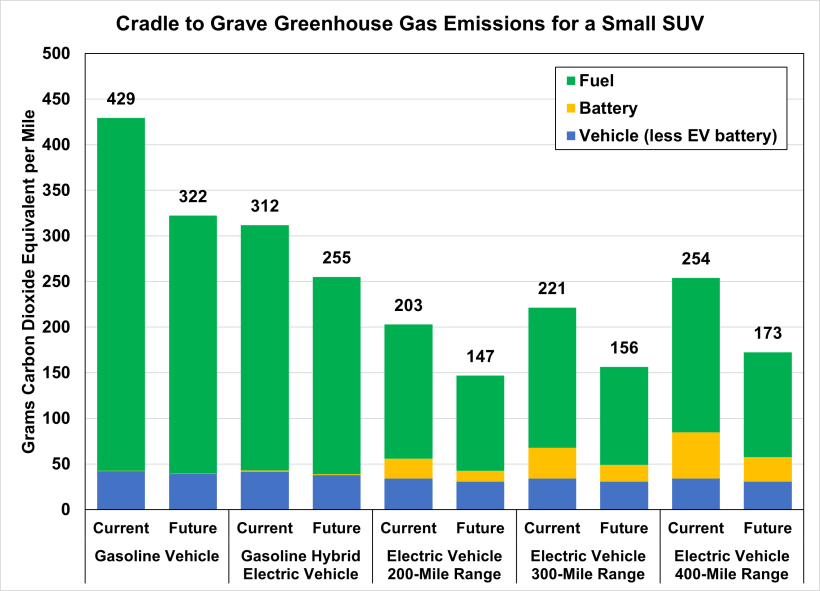
Cradle-to-grave greenhouse gas (GHG) emissions for a small gasoline SUV in 2020 were estimated to be 429 grams of carbon dioxide equivalent (CO2e) per mile, while the same size EV with 300 miles of range had 48% fewer GHG emissions. Argonne National Laboratory’s (Argonne) cradle-to-grave analysis considered everything from raw material extraction to vehicle scrappage to provide a holistic view of the sustainability of different vehicle and fuel technologies. The analysis showed that EVs (which have no tailpipe emissions) also have fewer GHG emissions than conventional gasoline or hybrid electric vehicles when the entire life cycle is considered. Argonne also provided emission estimates for technology anticipated to be available in 2030–2050.
This analysis includes emissions related to raw material extraction, fuel production and transport, vehicle manufacturing, vehicle use, and vehicle end-of-life, but not supporting infrastructure systems (e.g., refineries end-of-life or roads and bridges).
For electric vehicles, Argonne used the average U.S. electricity mix.
Future technologies are potential future vehicle efficiency gains based on the adoption of advanced technologies in the U.S. in the 2030‒2035 timeframe.
Vehicle lifetime was assumed to be 178,102 miles for all vehicle types.
Source: Kelly, Jarod C., Elgowainy, Amgad, Isaac, Raphael, Ward, Jacob, Islam, Ehsan, Rousseau, Aymeric, Sutherland, Ian, Wallington, Timothy J., Alexander, Marcus, Muratori, Matteo, Franklin, Matthew, Adams, Jesse, & Rustagi, Neha. Cradle-to-Grave Lifecycle Analysis of U.S. Light-Duty Vehicle-Fuel Pathways: A Greenhouse Gas Emissions and Economic Assessment of Current (2020) and Future (2030-2035) Technologies. United States. https://doi.org/10.2172/1875764
Fact #1303 Dataset. Courtesy of U.S. DOE, 2023 Fact of the Week.
I don’t like paywalls. You don’t like paywalls. Who likes paywalls? Here at CleanTechnica, we implemented a limited paywall for a while, but it always felt wrong — and it was always tough to decide what we should put behind there. In theory, your most exclusive and best content goes behind a paywall. But then fewer people read it! We just don’t like paywalls, and so we’ve decided to ditch ours. Unfortunately, the media business is still a tough, cut-throat business with tiny margins. It’s a never-ending Olympic challenge to stay above water or even perhaps — gasp — grow. So …





